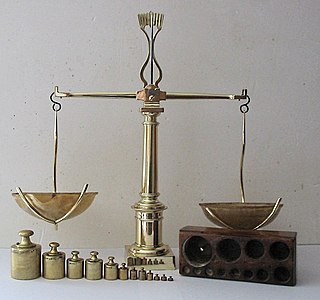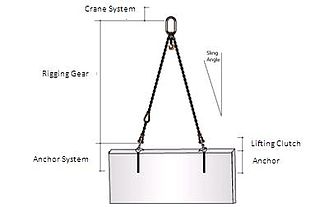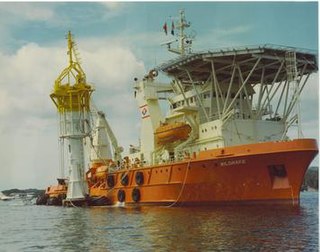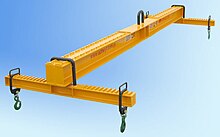
A skid loader, skid-steer loader, SSL, or skidsteer is any of a class of compact heavy equipment with lift arms that can attach to a wide variety of buckets and other labor-saving tools or attachments.

A counterweight is a weight that, by applying an opposite force, provides balance and stability of a mechanical system. The purpose of a counterweight is to make lifting the load faster and more efficient, which saves energy and causes less wear and tear on the lifting machine.

A block and tackle or only tackle is a system of two or more pulleys with a rope or cable threaded between them, usually used to lift heavy loads.

A crane is a machine used to move materials both vertically and horizontally, utilizing a system of a boom, hoist, wire ropes or chains, and sheaves for lifting and relocating heavy objects within the swing of its boom. The device uses one or more simple machines, such as the lever and pulley, to create mechanical advantage to do its work. Cranes are commonly employed in transportation for the loading and unloading of freight, in construction for the movement of materials, and in manufacturing for the assembling of heavy equipment.

A loader is a heavy equipment machine used in construction to move or load materials such as soil, rock, sand, demolition debris, etc. into or onto another type of machinery.

A backhoe—also called rear actor or back actor—is a type of excavating equipment, or digger, consisting of a digging bucket on the end of a two-part articulated arm. It is typically mounted on the back of a tractor or front loader, the latter forming a "backhoe loader". The section of the arm closest to the vehicle is known as the boom, while the section that carries the bucket is known as the dipper, both terms derived from steam shovels. The boom, which is the long piece of the backhoe arm attached to the tractor through a pivot called the king-post, is located closest to the cab. It allows the arm to pivot left and right, typically through a range of 180 to 200 degrees, and also enables lifting and lowering movements.

A lifting bag is an item of diving equipment consisting of a robust and air-tight bag with straps, which is used to lift heavy objects underwater by means of the bag's buoyancy. The heavy object can either be moved horizontally underwater by the diver or sent unaccompanied to the surface.

A scale or balance is a device used to measure weight or mass. These are also known as mass scales, weight scales, mass balances, and weight balances.

A derrick is a lifting device composed at minimum of one guyed mast, as in a gin pole, which may be articulated over a load by adjusting its guys. Most derricks have at least two components, either a guyed mast or self-supporting tower, and a boom hinged at its base to provide articulation, as in a stiffleg derrick. The most basic type of derrick is controlled by three or four lines connected to the top of the mast, which allow it to both move laterally and cant up and down. To lift a load, a separate line runs up and over the mast with a hook on its free end, as with a crane.

A gantry crane is a crane built atop a gantry, which is a structure used to straddle an object or workspace. They can range from enormous "full" gantry cranes, capable of lifting some of the heaviest loads in the world, to small shop cranes, used for tasks such as lifting automobile engines out of vehicles. They are also called portal cranes, the "portal" being the empty space straddled by the gantry.

An overhead crane, commonly called a bridge crane, is a type of crane found in industrial environments. An overhead crane consists of two parallel rails seated on longitudinal I-beams attached to opposite steel columns by means of brackets. The traveling bridge spans the gap. A hoist, the lifting component of a crane, travels along the bridge. If the bridge is rigidly supported on two or more legs running on two fixed rails at ground level, the crane is called a gantry crane or a goliath crane.

An aerial crane or flying crane is a helicopter used to lift heavy or awkward loads. As aerial cranes, helicopters carry loads connected to long cables or slings in order to place heavy equipment when other methods are not available or economically feasible, or when the job must be accomplished in remote or inaccessible areas, such as the tops of tall buildings or the top of a hill or mountain, far from the nearest road. Helicopters were first used as aerial cranes in the 1950s, but it was not until the 1960s that their popularity in construction and other industries began to catch on. The most consistent use of helicopters as aerial cranes is in the logging industry to lift large trees out of rugged terrain where vehicles are not able to reach, or where environmental concerns prohibit roadbuilding. These operations are referred to as longline because of the long, single sling line used to carry the load.

Material handling equipment (MHE) is mechanical equipment used for the movement, storage, control, and protection of materials, goods and products throughout the process of manufacturing, distribution, consumption, and disposal. The different types of equipment can be classified into four major categories: transport equipment, positioning equipment, unit load formation equipment, and storage equipment.

A container spreader is a tool used for lifting containers and unitized cargo. The spreader is placed between the container and the lifting machine.
A bucket is a specialized container attached to a machine, as compared to a bucket adapted for manual use by a human being. It is a bulk material handling component.

An ironworker is a tradesman who works in the iron-working industry. Ironworkers assemble the structural framework in accordance with engineered drawings and install the metal support pieces for new buildings. They also repair and renovate old structures using reinforced concrete and steel. Ironworkers may work on factories, steel mills, and utility plants.

A cargo hook is a device suspended below a helicopter and allows the transport of external loads during flight. Common terms for this operation include slingwork, underslung loads, external loadwork, and external load operations.

Rigging is both a noun, the equipment, and verb, the action of designing and installing the equipment, in the preparation to move objects. A team of riggers design and install the lifting or rolling equipment needed to raise, roll, slide or lift objects such as heavy machinery, structural components, building materials, or large-scale fixtures with a crane, hoist or block and tackle.

The Wildrake diving accident was an incident in Scotland in August 1979 that killed two American commercial divers. During a routine dive in the East Shetland Basin of the North Sea, the diving bell of the diving support vessel MS Wildrake became separated from its main lift wire at a depth of over 160 metres (520 ft). Although the bell was eventually recovered by Wildrake, its two occupants, 32-year-old Richard Arthur Walker and 28-year-old Victor Francis "Skip" Guiel Jr., died of hypothermia. The accident resulted in extensive subsequent litigation and led to important safety changes in the diving industry.

A jib or jib arm is the horizontal or near-horizontal beam used in many types of crane to support the load clear of the main support. An archaic spelling is gib.




















